Adrian Collins's Blog, page 56
May 14, 2024
REVIEW: The Savage Sword of Conan #2 Jim Zub (W), Richard Pace (A), and Patch Zircher (W, A)
Following a strong first issue, the second bimonthly installment of Titan Comics revived version of The Savage Sword of Conan has arrived. The eye-catching painted cover illustration by veteran artist Dave Dorman (Star Wars, Aliens: Tribes, etc.) shows an axe-wielding Conan locked in combat with a multilegged monstrosity atop a pile of skulls.
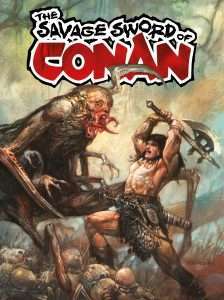 The cover feature for this issue is “Conan: Leaving the Garden,” penned by Jim Zub with art by Richard Pace (Batman: The Doom That Came to Gotham, etc.). Conan awakens to find himself buried alive, the caravan he was guarding devastated by bizarre, tusked humanoids. “Crom’s children are too stubborn to die,” muses Zub, and the barbarian hauls himself out of his grave through sheer force of will. Grievously wounded and with danger nearby, Conan must keep a low profile while learning more about the warped creatures that massacred his companions. A curious local boy offers Conan his assistance, but it soon becomes clear that the innocent child is enmeshed in a twisted culture. Zub’s storytelling is muscular and solid as usual, and through Conan’s interactions with the boy Zub shows a paternal side of Conan not often seen. Dark and sketchy, Pace’s artwork has an almost expressionistic feel that suits the grim mood of the narrative. The thick blacks and contorted facial expressions are especially effective in the early panels as Conan struggles his way to the surface.
The cover feature for this issue is “Conan: Leaving the Garden,” penned by Jim Zub with art by Richard Pace (Batman: The Doom That Came to Gotham, etc.). Conan awakens to find himself buried alive, the caravan he was guarding devastated by bizarre, tusked humanoids. “Crom’s children are too stubborn to die,” muses Zub, and the barbarian hauls himself out of his grave through sheer force of will. Grievously wounded and with danger nearby, Conan must keep a low profile while learning more about the warped creatures that massacred his companions. A curious local boy offers Conan his assistance, but it soon becomes clear that the innocent child is enmeshed in a twisted culture. Zub’s storytelling is muscular and solid as usual, and through Conan’s interactions with the boy Zub shows a paternal side of Conan not often seen. Dark and sketchy, Pace’s artwork has an almost expressionistic feel that suits the grim mood of the narrative. The thick blacks and contorted facial expressions are especially effective in the early panels as Conan struggles his way to the surface.
Also included in this issue is “Master of the Hunt, Part Two,” once again written and illustrated by Patrick “Patch” Zircher. Solomon Kane continues his search for the missing Maddocks boy and the hairy beast responsible for a string of disappearances and livestock killings. He’s accompanied on the trail by Old Gruffudd, an elderly blind man who seems to have insight into the recent supernatural goings-on in the Welsh countryside. While the artwork remains stunning, the plot didn’t progress as much as I would’ve have liked in this exposition-heavy installment. The ultimate showdown is nigh, however, as the finale is set to appear in The Savage Sword of Conan #3.
Bonus material includes three full-page pinup illustrations—two of Conan and one depicting Solomon Kane—and the Chainmail letters page. In response to a reader’s letter, the editor promises not only that readers can count on more gorgeous painted covers in the future, but that they’ll also specifically relate to a story within the issue. (Something readers always haven’t been able to count on with the past incarnation of The Savage Sword of Conan.) It’s also mentioned that, while Conan will naturally remain the primary draw, other Robert E. Howard characters beyond him and Solomon Kane will be featured in future issues of the magazine.
While not quite as packed to the brim as the debut issue—there’s no short story this time, and one fewer pinup—The Savage Sword of Conan #2 remains an entertaining read for fantasy adventure fans.
Read The Savage Sword of Conan #2 Jim Zub (W), Richard Pace (A), and Patch Zircher (W, A)The post REVIEW: The Savage Sword of Conan #2 Jim Zub (W), Richard Pace (A), and Patch Zircher (W, A) appeared first on Grimdark Magazine.
May 13, 2024
Rare editions for charity, crowd funding projects, protecting reader communities–this Grim Oak Press publisher talk has it all
Shawn Speakman drops by the channel to talk all things Grim Oak Press books and his writing, including an exclusive announcement about something that’s been sitting on shelves for years and is about to hit the auction block in support of authors who are struggling with medical bills. Shawn is one of my personal publishing heroes, so I was really excited to be able to spend time with somebody I look up to.
We talk the business of publishing, including bindery problems, kickstarters, modern small publishing funding and the cost of business, protecting communities, a brand new anthology UNAVOWED focussed on indie authors, and Shawn’s new Backerkit funding drive for The Dark Thorns (and all the awesome things you’ll get by following that project)!
Unfortunately the video recording hasn’t done us any favours, with Shawn being paused every few seconds for a couple hundred glamour photos, but the audio is perfect, so jump in and listen to one of the great small press owners let us know what’s coming.
Sign up to find out moreSign up to the Backerkit for The Dark Thorn by Shawn Speakman by clicking on the image below.
The post Rare editions for charity, crowd funding projects, protecting reader communities–this Grim Oak Press publisher talk has it all appeared first on Grimdark Magazine.
May 12, 2024
REVIEW: The Savage Sword of Conan #1 by John Arcudi (W), Jim Zub (W), and Max von Fafner (A)
Shortly after Titan Comics announced the return of the Conan the Barbarian, the next question on fans’ lips was if companion series The Savage Sword of Conan would see a similar revival. Originally launched in the mid-1970s, a few years after the Marvel Comics debut of Conan the Barbarian, The Savage Sword of Conan differentiated itself from its four-color predecessor by adopting a more adult approach. As a black-and-white magazine, The Savage Sword of Conan wasn’t subject to the regulations of the Comics Code Authority, and as a result it was able to portray levels of violence and sensuality that were off-limits in the mainstream Conan title. Many readers enjoyed the added grit and mature tone of the magazine during the classic Marvel Comics run, and after such a long absence curiosity abounded regarding what a modern-day Titan Comics incarnation would look like. (Before losing the Conan license for the second time, Marvel Comics briefly revived the title for 12 issues from 2019-2020, but in this reviewer’s opinion this short-lived version did not significantly differentiate itself in terms of format or content from their parent Conan the Barbarian title.) The first issue of the relaunched The Savage Sword of Conan arrived simultaneously with Conan the Barbarian issue #8, finally giving readers basis for comparison.
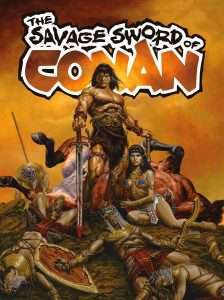 Fortunately, this first issue seems geared to put longtime fans of The Savage Sword of Conan at ease. The standard cover artwork features a bold painting by Marvel Comics-era veteran Joe Jusko, showing Conan standing victorious over a pile of slain warriors in Stygian (i.e., Egyptian-themed) garb, a beautiful bronze-skinned maiden at his side. Precisely the sort of cover readers would have been welcomed with during the original magazine’s heyday. The nostalgic artwork is immediately followed up by a foreword by Roy Thomas, the fan-favorite writer and editor responsible for introducing the character of Conan to the comic book medium. Thomas provides some insight into the launch of the original magazine in the mid-70s and concludes with some tantalizing hints that he may be returning to the Conan character in future issues of Titan Comics’ incarnation.
Fortunately, this first issue seems geared to put longtime fans of The Savage Sword of Conan at ease. The standard cover artwork features a bold painting by Marvel Comics-era veteran Joe Jusko, showing Conan standing victorious over a pile of slain warriors in Stygian (i.e., Egyptian-themed) garb, a beautiful bronze-skinned maiden at his side. Precisely the sort of cover readers would have been welcomed with during the original magazine’s heyday. The nostalgic artwork is immediately followed up by a foreword by Roy Thomas, the fan-favorite writer and editor responsible for introducing the character of Conan to the comic book medium. Thomas provides some insight into the launch of the original magazine in the mid-70s and concludes with some tantalizing hints that he may be returning to the Conan character in future issues of Titan Comics’ incarnation.
Written by John Arcudi with artwork by Max von Fafner, “Conan and the Dragon Horde” is this issue’s main feature. Self-contained and unconnected to the ongoing Conan the Barbarian storyline, this comic portrays Conan as the leader of a mercenary band in service to an exiled Hyrkanian prince. Prince Zaahid promises riches untold to any man who helps him retake the throne from his estranged brother, but it soon becomes clear that Zaahid is keeping deadly secrets from his underlings. Increasingly skeptical and restless, Conan finds himself at odds with his employer. Not only must he deal with the giant, scaled beast defending Zaahid’s desired throne, Conan must guard himself against the lions and twin brutes that guard the prince. “Conan and the Dragon Horde” packs a great deal of adventure, violence, and sensuality within its 48 pages. Some may find the art style somewhat unconventional, but the exaggerated, detailed musculature on display vaguely reminded me of the Baki the Grappler manga by Keisuke Itagaki.
Conan the Barbarian writer Jim Zub’s contribution is something a little different than what we’re used to seeing from him: a prose story, rather than a comic. “Sacrifice in the Sand” is a short story based on Jusko’s Egyptian-themed cover artwork. The tale involves a Stygian captain named Nkosi, escorting a beautiful captive across the desert to be sacrificed as a bride of the snake god Set. Conan is depicted similarly to a stalking beast, striking from ambush to thin the numbers of Nkosi’s warrior band before ultimately pitting his sword against the captain in single combat. It was interesting to see Zub try his hand at regular fiction. When compared to Conan creator Robert E. Howard, Zub’s prose writing feels a little on the verbose side; Howard could have doubtless covered more ground given the same word count. But Zub’s enthusiasm is palpable, and he delivers an exciting vignette.
The final comic of the issue is “Master of the Hunt, Part One,” both written and illustrated by Patrick “Patch” Zircher. Instead of Conan, this story focuses on another of Howard’s literary creations: the vengeful Puritan swordsman Solomon Kane. Set in Wales, “Master of the Hunt” is a moody, gothic affair. Wandering through the countryside, rootless adventurer Solomon Kane encounters a family whose sheep have been rent apart in the night by a mysterious, hairy beast. With the husband away tracking the monster, Kane pauses to lend a hand to the Maddocks household’s wife and young son. An eerie appearance by Lord Arawn of the mythical Fair Folk leads Kane to become further embroiled in the family’s plight, and he vows to get to the bottom of the mystery. Backup stories featuring Kane were an occasional part of the Marvel Comics series, and his return in the Titan Comics reboot is a welcome one. So far Zircher’s depiction of the character seems a faithful one and his artwork is exquisite.
Other materials included in this inaugural issue include pinup illustrations of Conan and other characters, a map of the Hyborian Age, and an essay by Howard scholar Jeffrey Shanks providing additional background and publication details for Solomon Kane.
The days of the Comics Code Authority have long since passed, and Titan Comic’s Conan the Barbarian hasn’t shown any reluctance to depict either violence or (non-explicit) nudity. Is there still a niche for The Savage Sword of Conan to fill? Even lacking an all-ages/mature division in content between the two titles, I would argue that this magazine is a welcome addition to Titan Comics’ stable. With the ongoing Black Stone plot, the main Conan the Barbarian title appears increasingly invested in long-form storytelling, making The Savage Sword of Conan an ideal venue for shorter, standalone pieces. The primary title has committed itself to four-issue story arcs—so far with one writer and one artist per arc—but there is no need for The Savage Sword of Conan to play it safe; I hope to see further experimentation in terms of artwork and creative teams in future issues of the magazine. And as demonstrated with Solomon Kane in this issue, The Savage Sword of Conan also serves as a natural platform for the reintroduction of other long-dormant Howard characters to today’s audience. If the level of quality and variety on display in issue #1 of The Savage Sword of Conan is maintained, the magazine has the potential to surpass even the flagship Conan the Barbarian comic.
Read The Savage Sword of Conan #1 by John Arcudi (W), Jim Zub (W), and Max von Fafner (A)The post REVIEW: The Savage Sword of Conan #1 by John Arcudi (W), Jim Zub (W), and Max von Fafner (A) appeared first on Grimdark Magazine.
May 11, 2024
REVIEW: When the Blood Has Dried #2 by Gary Moloney (W) and Daniel Romero (A)
In the previous issue of When the Blood Has Dried, we learned that Meabh, a former adventurer and member of the Adventurer’s Guild turned-tavern owner, is dealing with the Guild’s return to her life. There’s a proposition to build an outpost right in Carraig An Bhun, and in When the Blood Has Dried #2, we see the aftermath of that proposition, with the return of the very man who tried to kill her: the famous adventurer Darius.
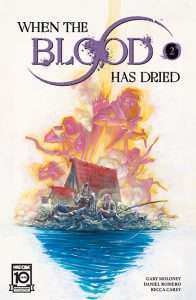 When the Blood Has Dried #2 is more of a reactionary issue to the previous one, giving us more insight into who Meabh is and what her true feelings to the Guild are. When there’s a town hall held to see if they should actually build the outpost, she makes her feelings plain as to why holding the Guild here would be bad. It’s the appearance of Darius, her former ally, her attacker, and a famous member of the Guild, that shakes things up for Meabh. Darius is charismatic but ultimately dangerous. He’s as surprised as anyone to see Meabh still alive, and it seems as though he may still hold some of those violent tendencies towards her.
When the Blood Has Dried #2 is more of a reactionary issue to the previous one, giving us more insight into who Meabh is and what her true feelings to the Guild are. When there’s a town hall held to see if they should actually build the outpost, she makes her feelings plain as to why holding the Guild here would be bad. It’s the appearance of Darius, her former ally, her attacker, and a famous member of the Guild, that shakes things up for Meabh. Darius is charismatic but ultimately dangerous. He’s as surprised as anyone to see Meabh still alive, and it seems as though he may still hold some of those violent tendencies towards her.
What I appreciated was learning more about the world in this issue. When the Blood Has Dried has a war going on, which is the impetus for building Adventurer’s Guilds across the land. Using war as an excuse to bring adventurer’s to town – a prospect that Meabh warns could leave the town in a bad way – seems to be Darius’s game, so it’ll be interesting to see why he holds the Guild in such a high regard, even so far as trying to kill Meabh in the flashback sections.
As in the previous issue, When the Blood Has Dried #2 boasts some impressive writing and art. Daniel Romero’s art and colors are expressive and animated, and I noticed that the colors seemed a bit muted as in the previous issue. If this is a response to Meabh’s outlook on things – life isn’t so bright when your past is literally coming back to haunt you – then it’s a nice touch. The standout character in this issue is Darius himself: he’s written as calculating, violent, but he can easily win the townsfolk over if he puts on the right smile. He’s a great potential villain, and I’m interested to see what his plans for Carraig An Bhun – and for Meabh herself – are. The issue ends with the proposition that Darius and Meabh might be working closer than either is comfortable with, so we’re sure to see drama – and possibly violence – in the next When the Blood Has Dried.
With excellent writing and art, this series is already off to the races to being a fascinating insight to the role adventurer’s take on in fantasy stories: they’re not always good, they usually leave things messier than they found it, and Meabh will be damned if she’s going to let that happen to her a second time.
The post REVIEW: When the Blood Has Dried #2 by Gary Moloney (W) and Daniel Romero (A) appeared first on Grimdark Magazine.
May 10, 2024
REVIEW: Hills of Heather and Bone by K.E. Andrews
Hills of Heather and Bone is the dark yet delicate fantasy by K.E. Andrews, which finished a (very) close second place in Mark Lawrence’s ninth Self-Published Fantasy Blog-Off (SPFBO9).
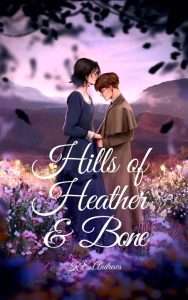 The story revolves around a young married couple who possess magical powers over the living and the dead. Percy is a rootsower, gifted with the ability to grow and manipulate plants. His wife, Morana, is a boneweaver who can connect to the deceased through their skeletal remains and even raise them from the dead:
The story revolves around a young married couple who possess magical powers over the living and the dead. Percy is a rootsower, gifted with the ability to grow and manipulate plants. His wife, Morana, is a boneweaver who can connect to the deceased through their skeletal remains and even raise them from the dead:
“Fresh deaths are always the strongest—the loudest, the most painful. Memories are more vivid in their final moments. The body remembers what the soul leaves behind.”
Boneweavers like Morana are misunderstood and feared by the general population. The couple’s peaceful life is upended when Morana’s abilities are discovered and they are forced to abandon their home and live a life on the run.
The world of Hills of Heather and Bone has a rustic cabincore feel inspired by the Scottish countryside. The novel also features one of my favorite animal sidekick characters: Morana’s cranky and judgmental pet chicken, the aptly named Morhenna.
The nature-based magic system created by K.E. Andrews is a perfect fit for the pastoral setting of the novel. Boneweavers and rootsowers are just two types of the so-called bloodgifted, who possess supernatural connections to the natural world. A few other categories of bloodgifted include: beastcharmers, who can speak with and control animals; earthcarvers, with the ability to move and shape the earth; fleshmenders, who can heal flesh; waterdancers, who can manipulate water; and windsingers, who can summon and shape the wind.
The core of Hills of Heather and Bone is the loving relationship between Morana and Percy. The maturity and genuine love expressed in their relationship, through both words and actions, is a welcome contrast to the shallowness of romantic entanglements found in many romance and romantasy books.
Morana and Percy share a healthy and positive relationship, but they also face many realistic problems:
“A fragment of a memory jolts through me, a baby held in roughened hands. Tears sting my eyes. Percy looks at me, his brow wrinkled with a question I don’t want to answer.”
Percy, whose full name is Percival, is such a cinnamon roll. His personality reminds me of Sir Percival, one of the Knights of the Round Table, who has a childlike innocence which protects him from worldly temptation. Morana and Percy also defy the usual physical representation of couples in romance books. The axe-wielding Morana is much taller and stronger than her delicate, scholarly husband, and she also suffers from chronic pain:
“My arthritis has been with me since I was five. I felt like an old woman shuffling around when the pain got bad, struggling to keep up with my siblings or walking the hills with the cows.”
I was already a fan of K.E. Andrews from reading her previous SPFBO8 semi-finalist, The Assassin of Grins and Secrets, but she has really leveled up with Hills of Heather and Bone. Her prose, told from Morana’s first-person perspective, recalls that of Sarah Chorn in its dark but eloquent beauty. Reading Hills of Heather and Bone feels like listening to a Midlake album with its charming melancholy.
Hills of Heather and Bone is also much darker than one might assume by its cover, featuring plenty of necromancy. With this book, I’d argue that K.E. Andrew has essentially invented a new subgenre of “cozy grimdark” fantasy. There is even a reference to the Dripping Bucket, Michael R. Fletcher’s interdimensional grimdark tavern that has been embraced by a multitude of dark fantasy authors.
Hills of Heather and Bone also has strong mental health themes, including overcoming grief and depression:
“I wrap my arm around him and stroke his damp hair. His shoulders heave with quiet sobs. We cling to each other while the world continues to turn.”
Overall, Hills of Heather and Bone strikes the perfect balance between darkness and hope. K.E. Andrews has written a rustic gem of a novel, a deeply emotional story built around a realistic, loving couple who resonated deeply with me as a reader.
I originally reviewed this novel as part of the Before We Go Blog team with SPFBO9.
Read Hills of Heather and Bone by K.E. AndrewsThe post REVIEW: Hills of Heather and Bone by K.E. Andrews appeared first on Grimdark Magazine.
May 9, 2024
REVIEW: The Wind-Up Bird Chronicle by Haruki Murakami
The Wind-Up Bird Chronicle is a dark masterpiece of magical realism, establishing Japanese author Haruki Murakami as one of the world’s foremost voices in speculative fiction and a perennial contender for the Nobel Prize in Literature.
I first discovered Murakami’s work in my early twenties, devouring all his published work in the years following my college graduation. The Wind-Up Bird Chronicle became my favorite novel, impacting me in subtle ways that have become a core part of who I am today.
I have revisited The Wind-Up Bird Chronicle each decade since my original read in 2004. I know it’s the same book, but it feels different each time. My format for this review is directly inspired by Mark Lawrence’s recent short story, “About Pain,” which contains the following quote:
“You cannot read the same book twice. When you return to the first page it will be a different ‘you’, changed by the very experiences you are seeking to recapture.” (Mark Lawrence)
 2004: After , I feel fortunate to have discovered a long list of novels that I adore, books where I feel a strong personal connection with the characters and themes being explored. Most of all, these are books that have helped me to think in a new way, or to somehow broaden or deepen my understanding of our place in the world and our relationships with each other.
2004: After , I feel fortunate to have discovered a long list of novels that I adore, books where I feel a strong personal connection with the characters and themes being explored. Most of all, these are books that have helped me to think in a new way, or to somehow broaden or deepen my understanding of our place in the world and our relationships with each other.
I don’t always give the same response when people ask me which book is my all-time favorite. It depends on my mood, and there is also some recency bias depending on which books I have recently enjoyed. Despite these reservations, in my heart I know that I’ve converged on an answer: The Wind-Up Bird Chronicle by Haruki Murakami. I feel like a different person after reading this book, like I’m somehow more attuned to the ways in which people treat each other and the metaphysical reality hiding just beneath the surface of our everyday lives.
The Wind-Up Bird Chronicle is a very difficult book to summarize, with a number of disparate plot lines that all converge at the end. I’m not going to attempt to write a plot summary or even a character summary. What stands out to me most is how Murakami blurs the line between the real and surreal. The main protagonist, Toru Okada, is so passive in our physical world and can only grow by entering the metaphysical realm:
“In a place far away from anyone or anywhere, I drifted off for a moment.”
Murakami makes such effective use of magical realism here, as he does in many of his other novels. But The Wind-Up Bird Chronicle is somehow different. The magical elements are not meant to be fantasy: they are meant to be a deeper level of our true reality.
It’s hard to describe how much The Wind-Up Bird Chronicle means to me or how much it has impacted me. I feel like it somehow deepened my consciousness and, in doing so, made me a better person in some small way.
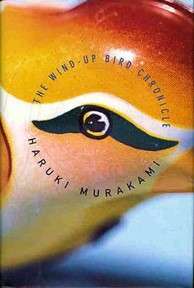 2014: A decade older. Am I ten years wiser or just more jaded?
2014: A decade older. Am I ten years wiser or just more jaded?
I’ve read a lot of great books over the past ten years, yet The Wind-Up Bird Chronicle is still my favorite. However, it seems significantly darker this second time around.
Ten years ago, I would have told you that the main theme of The Wind-Up Bird Chronicle is transcendence: discovering our true selves by digging deep into our souls, perhaps with a little help from some unlikely friends. But I missed the point.
Returning to The Wind-Up Bird Chronicle in my thirties, the overarching theme is cruelty: not the cruelty of an uncaring universe, but rather the cruelty that people inflict on each other, either purposely or just plain carelessly.
Murakami covers cruelty on both personal and global levels. There is the small-scale cruelty that people inflict on each other within a relationship. When The Wind-Up Bird Chronicle opens, the narrator (Toru) is obsessed with the search for his lost cat. However, he is focused on the what rather than the why. Toru should be asking why the cat left in the first place, since this seemingly innocuous event is the harbinger for the impending breakdown of his marriage with his wife, Kumiko:
“I realize full well how hard it must be to go on living alone in a place from which someone has left you, but there is nothing so cruel in this world as the desolation of having nothing to hope for.”
Kumiko’s troubles stem from the inexplicable cruelty inflicted on her by her brother, Noburo, who is a slick, media-savvy politician, well-loved by the public, but also a sadistic abuser, especially toward his two sisters. Noburo’s abuse is cruelty for the sake of cruelty, committed by a twisted soul.
Murakami pairs these personal stories of cruelty with violence committed on a much larger scale during World War II. There is a very clear political aspect to The Wind-Up Bird Chronicle, with Murakami criticizing his own government, which has been much more reluctant than Germany to admit its atrocities during the war, issue apologies, and make reparations. I really admire what Murakami is doing here in bringing the atrocities of the war front and center, entreating the public to come face-to-face with this cruel past.
Murakami doesn’t restrict his criticism to Japanese violence during World War II. On the other side of the war, the Soviets were equally cruel. In The Wind-Up Bird Chronicle, the embodiment of this cruelty is Boris the Manskinner. The scenes with Boris are some of the most excruciating of the entire book and have seared a permanent image in my memory.
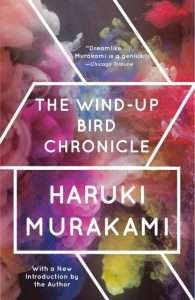 2024: I keep coming back to The Wind-Up Bird Chronicle, a book that has left a permanent mark on me much like the blue mark left on the face of our protagonist, Toru, after his transcendent experience at the bottom of the well. Reading The Wind-Up Bird Chronicle feels like coming home, but it’s not the home I remember:
2024: I keep coming back to The Wind-Up Bird Chronicle, a book that has left a permanent mark on me much like the blue mark left on the face of our protagonist, Toru, after his transcendent experience at the bottom of the well. Reading The Wind-Up Bird Chronicle feels like coming home, but it’s not the home I remember:
“Memories and thoughts age, just as people do. But certain thoughts can never age, and certain memories can never fade.”
May Kasahara has always been one of my favorite characters from the book: a sixteen-year-old girl obsessed with aging and death, yet she is such a vibrant presence in this bleak world, even if she does have a bit of a sadistic streak:
“You know, Mr. Wind-Up Bird, I sometimes wonder what it must feel like to die little by little over a long period of time. What do you think?”
It feels weird that despite May’s obsession with aging, she is exactly the same age as when I first picked up the book in 2004. Instead, it is this unsuspecting reader who has aged twenty years, and I must admit that as a younger man I missed the crux of this novel.
It’s about pain. It’s the pain of being human, a pain that is core to our existence. We seek to escape this pain, but the only way to escape pain is to abandon our very selves. Consider this quote from Creta Kano, who endured unspeakable cruelty but eventually came to numb herself from the pain:
“A life without pain: it was the very thing I had dreamed of for years, but now that I had it, I couldn’t find a place for myself within it.”
In my twenties I thought that The Wind-Up Bird Chronicle was about transcendence. But now it seems to be more about acceptance. We become better people by accepting our identities, becoming truer versions of ourselves while also becoming more aware and understanding of each other.
We all suffer through pain: this is part of our common existence. The core message of The Wind-Up Bird Chronicle is that there is hope in suffering. We become better people by looking inward in discovering a truer sense of ourselves, but more importantly by looking outward at the people we love, the people we hate, and the strangers we pass by on the street who may be just friends we haven’t met yet.
I know The Wind-Up Bird Chronicle is the same book I read twenty years ago, but somehow it feels different each time. What will I learn from this book in ten years’ time? I have no idea, but I hope that I will have grown as a person by then.
I also hope that, by next time, the Nobel Prize committee will have finally honored Haruki Murakami for the sheer genius that is The Wind-Up Bird Chronicle, a novel that remains without peer more than twenty years since its original publication and, I’d argue, the foremost example of grimdark magical realism.
Read The Wind-Up Bird Chronicle by Haruki MurakamiThe post REVIEW: The Wind-Up Bird Chronicle by Haruki Murakami appeared first on Grimdark Magazine.
May 8, 2024
REVIEW: Dark Dreams of Nilztiria by D.M. Ritzlin
The follow-up to 2020’s Necromancy in Nilztiria, Dark Dreams of Nilztiria collects nine more sword & sorcery stories set in D.M. Ritzlin’s setting, Nilztiria. While several characters from the previous volume reappear—including Xaarxool the Necromancer, barbarian hero Avok Kur Storn, and Vran the Chaos-Warped (also featured in the 2023 novel, Vran the Chaos-Warped), the stories here are self-contained, and no prior experience with the characters or setting is needed to enjoy this volume.
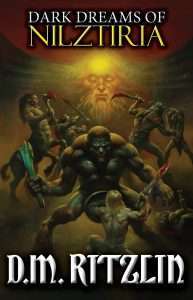 Dark Dreams of Nilztiria starts off strong with the cover story, “More Blood.” A warrior awakens in a phantasmagorical arena, with no memory of the circumstances leading up to his imprisonment. With no time to pause for reflection, he faces a series of increasingly strange opponents: twin martial artists, a jester armed only with his index finger, even a walrus. All the while, the colosseum echoes with a repeated cry for “Blood! More blood!” The nameless warrior battles his way to the arena’s bloodthirsty spectator but is unprepared for what he finds. “More Blood” boasts an intriguing atmosphere and a killer finishing line.
Dark Dreams of Nilztiria starts off strong with the cover story, “More Blood.” A warrior awakens in a phantasmagorical arena, with no memory of the circumstances leading up to his imprisonment. With no time to pause for reflection, he faces a series of increasingly strange opponents: twin martial artists, a jester armed only with his index finger, even a walrus. All the while, the colosseum echoes with a repeated cry for “Blood! More blood!” The nameless warrior battles his way to the arena’s bloodthirsty spectator but is unprepared for what he finds. “More Blood” boasts an intriguing atmosphere and a killer finishing line.
“The Necromancer and the Forgotten Hero” centers on a cat and mouse game between the necromancer Xaarxool and Acclain Dorso, the new magistrate in charge of the Bureau of Sorcerous Affairs in the city of Desazu. The pair’s rivalry has taken a nasty turn, with Dorso dispatching an assassin and a series of summoned monsters after Xaarxool. As he attempts to flee Desazu, Xaarxool brings some protection, however, in the form of legendary warrior Hyallbor. Revived 500 years after his death, Hyallbor finds himself ambivalent about his new lease on life. While resurrection is common in fantasy fiction, the exploration of necromancy from one of its subjects felt refreshing.
Like the story before it, “The Head in the Globe” stars another of Ritzlin’s recurring heroes: Avok Kur Storn. Wandering through the forest, the barbarian hero is approached by an alluring young woman who begs him to retrieve her father’s severed head from the top of a massive tree. Avok learns that the head remains quite alive, imprisoned in a glass sphere through the magic of Syrakoss, a warlock hoping to extort magical knowledge from the head. Avok discovers that reclaiming the head is the easy part of his task, as he soon finds himself caught in a struggle between two sorcerous heavyweights, dealing with treachery and a host of bizarre creatures. Fast-paced and subtly humorous, “The Head in the Globe” covers a great deal of ground in a scant 18 pages.
“Crowned in Madness” presents a dungeon delve from hell. After choosing the wrong victim to waylay, failed bandit Rythe finds himself press-ganged into the service of the arrogant wizard Altogg Keldoum. Keldoum’s band of mercenaries are on an expedition to loot a magical crown from a dead king’s tomb, but careless tavern chatter catches the ear of Verohssa, High Priestess of the BDSM-flavored cult of Tuntilla, the Sadistic Maiden. Disaster strikes deep within the tomb and Rythe is caught between a rock and a hard place, trying to preserve his own life while Keldoum and Verohssa struggle to possess the crown. Hapless Rythe’s constantly shifting allegiances add a welcome touch of wry humor to what is otherwise a very gory and grim tale.
The shortest episode in the collection, “Diabolical Symphonies” follows the ruthless sorceress Ytra as she prepares a powerful magical incantation to get revenge on her long list of enemies and rivals (including Xaarxool and Avok Kur Storn). Epic spellcraft demands rare components, and Ytra must go to great lengths to enact her mystical vengeance. Magic is fickle at best, however, and the stakes are high for Ytra as she grapples with ancient sorcery. This story is sure to be appreciated by readers left cold by the safely reliable, almost scientific depiction of magic common in much modern fantasy fiction.
Another story starring Xaarxool, “The City the Gods Abandoned” finds the necromancer stranded in the otherworldly city of Vantophai after a magical mishap. A local ruler immediately approaches Xaarxool, attempting to coerce him into assisting his takeover of Vantophai. Sorcerers are even more resistant to compulsion than cats, however, and Xarxool decides to extract himself from the situation in spectacular fashion. “The City the Gods Abandoned” feels a little on the long side, but Xaarxool’s magical MacGuyver-like solution to his plight makes up for the slower scenes.
The longest story in Dark Dreams of Nilztiria at 40 pages, “Inside a Dead God’s Skull” has a suitably epic premise. Maniacal sorcerer Rothalzeng embarks on a mission of conquest, using a religious cult and the giant corpse of a dead god to further his aims. It’s up to Avok Kur Storn, Xaarxool’s ally Lodianux, and others to stand against Rothalzeng. While “Inside a Dead God’s Skull” includes some of the most impressive imagery in the book, it suffers from an overabundance of named characters and some pacing issues. Exciting but overstuffed, “Inside a Dead God’s Skull” might have worked better as a full-length novel.
Where “Crowned in Madness” prominently featured a cult devoted to the goddess of pain, “The Curse of Ambition” focuses on a competing religion dedicated to Veshakul’a, the goddess of death. Dantorol, a young adherent of the cult, finds himself disillusioned with the apparent complacency of his church’s superiors. When an opportunity to seize power presents itself, he takes it. While Dantorol succeeds in growing the cult, he must deal with other, unintended results. While slightly on the cryptic side, this story is another example of the recurring theme of a Ritzlin character getting what they want, “good and hard” (to paraphrase H.L. Mencken).
“The Demon’s Oak” is another story dealing with religion. An oak tree outside of Desazu becomes animated, declaring itself to be Arnvar, the god of earth and nature. A cult soon springs up around the tree, but some suspect the self-declared god has an ulterior motive. Famed mercenary Vran is hired to remove his client’s daughter Ulrika from the influence of the cult, but his task is complicated by the hidden powers of the being inhabiting the tree and the unpredictable effects that result when magic is cast in his presence. “The Demon’s Oak” packs a lot of adventure into 36 pages, without the inconsistent pacing of “The City the Gods Abandoned” and “Inside a Dead God’s Skull.”
The stories collected in Dark Dreams of Nilztiria are grim and gory, but occasionally glimmers of wry humor shine through. Many of the shorts have ironic endings, where the protagonist gets exactly what they sought, but with disastrous results. And while many sword & sorcery authors demonstrate a strong preference for either sorcery or sword (e.g., emphasizing plucky swordsmen while casting wizards as the perennial villains), Ritzlin gives equal “screen time” to both brawny and brainy protagonists. It’s also entertaining how his cast of characters seem to wander through each other’s adventures, either appearing directly through cameos or via off-hand references.
While the sorceress Ytra is a fun character who gets to star in her own story and pain cultist Verohssa makes for an entertaining antagonist, overall women tend to occupy a peripheral role in the stories contained here. Apart from Ytra and Verohssa, women tend to be either in need of assistance (e.g., Ulrika in “The Demon’s Oak”) or absent entirely. Readers hoping to read about, say, a quick-witted rogue who happens to be a woman are destined to be disappointed. Ritzlin has an engaging cast of recurring male heroes, perhaps adding another woman to the mix could address this imbalance.
Delivering swordplay and spellcasting in equal measure, Dark Dreams of Nilztiria has much to offer fans of dark fantasy. While—as presented in this book—Nilztiria seems somewhat amorphous and undefined as a fantasy setting, Ritzlin’s characters are both distinct and appealing.
Read Dark Dreams of Nilztiria by D.M. RitzlinThe post REVIEW: Dark Dreams of Nilztiria by D.M. Ritzlin appeared first on Grimdark Magazine.
May 7, 2024
REVIEW: Murder at Spindle Manor by Morgan Stang
Murder at Spindle Manor is an ingeniously constructed murder mystery by Morgan Stang and winner of Mark Lawrence’s ninth Self-Published Fantasy Blog-Off (SPFBO9). Set inside a creepy mansion in a dark gaslamp fantasy world, Murder at Spindle Manor offers plenty to love for dark fantasy fans. Think of it as Agatha Christie meets Neil Gaiman, with a quirky sense of humor that rivals Knives Out.
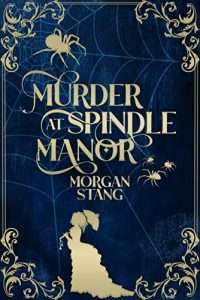 Isabeau Agarwal, the lead protagonist of Murder at Spindle Manor, combines a sharp intellect with the fighting skills and marksmanship of a professional sniper. Isabeau is a Huntress, tasked with tracking and exterminating a terrible monster known as the Doppelvyrm:
Isabeau Agarwal, the lead protagonist of Murder at Spindle Manor, combines a sharp intellect with the fighting skills and marksmanship of a professional sniper. Isabeau is a Huntress, tasked with tracking and exterminating a terrible monster known as the Doppelvyrm:
“Allow me to speak of the Doppelvyrm. They fear no light, for their only dream is to become human, and in the pursuit of that dream, they will kill countless men and women…The Doppelvyrm is a parasite. A grisly, ghastly parasite.”
The Doppelvyrm can perfectly mimic its human victims, adopting their physical form and absorbing their memories. Isabeau’s hunt brings her to Spindle Manor, where she suspects that one of the ten guests is actually the Doppelvyrm in disguise:
“Ten little guests, all collected and sat, met and filed away. Ten souls in one room, one of whom was not who they said they were.”
The influence of Agatha Christie is obvious from the quote above and from the general setup of the novel. Morgan Stang gleefully embraces and/or subverts a range of murder mystery tropes, including a mentor-mentee relationship reminiscent of Sir Arthur Conan Doyle’s pairing of Sherlock Holmes and Dr. Watson.
Playing the role of Watson in Murder at Spindle Manor is Evie, an apprentice of sorts to Isabeau who gives our protagonist the opportunity to explain her thought process out loud as she considers various hypotheses. Evie herself is an interesting character who becomes more intriguing over the course of the novel.
With its large cast of characters and fast-paced plot, I was pleasantly surprised that I became emotionally invested in several of the characters, especially Isabeau. Morgan Stang did an outstanding job bringing each of these characters vibrantly to life and building sympathy for several of them.
The fantasy world of Murder at Spindle Manor is also a treat, featuring necromancy, a variety of bizarre and frightening creatures, and a healthy dose of steampunk. There is plenty of humor here as well, such as the author including herself on the guest list at Spindle Manor.
Murder at Spindle Manor has it all: mystery, fantasy, horror, comedy, and even a touch of romance. All of this comes together to make a perfectly plotted whodunnit amounting to the craziest game of Clue that I’ve ever played.
I originally reviewed this novel as part of the Before We Go Blog team with SPFBO9.
The post REVIEW: Murder at Spindle Manor by Morgan Stang appeared first on Grimdark Magazine.
May 6, 2024
REVIEW: When the Blood Has Dried by Gary Moloney (W) and Daniel Romero (A)
When the Blood Has Dried #1 wants you to realize that being an adventurer sucks. With gorgeous colors and a solid first look into what could be a fun fantasy romp, When the Blood Has Dried #1 is an interesting take on what adventurers do once the adventuring is done, and that the past never stays buried.
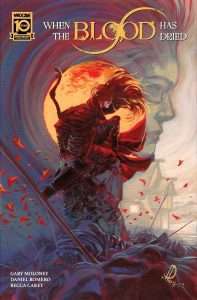 Meabh is a retired adventurer, once a member of the so far undefined Adventurer’s Guild. Her tenure with the Guild ended in blood when her former ally Darius left her for dead. Years after her escape, she’s the barkeep in a cozy little tavern – Traolock’s – in the peaceful town of Carraig an Bhun. This issue evokes traditional fantasy tropes with a bit of Irish flavoring to it. Those who start their Dungeons & Dragons campaigns in taverns will find themselves quite at home at Traolock’s. With the threat of a possible Adventurer’s Guild outpost being built right in Meabh’s own front yard, we see that Meabh’s past is going to come back in possibly violent ways. When the Blood Has Dried #1 boasts a little bit of Western vibes in there too. One could easily predict this turns into a bloody revenge tale when someone from Meabh’s past arrives in Carraig an Bhun.
Meabh is a retired adventurer, once a member of the so far undefined Adventurer’s Guild. Her tenure with the Guild ended in blood when her former ally Darius left her for dead. Years after her escape, she’s the barkeep in a cozy little tavern – Traolock’s – in the peaceful town of Carraig an Bhun. This issue evokes traditional fantasy tropes with a bit of Irish flavoring to it. Those who start their Dungeons & Dragons campaigns in taverns will find themselves quite at home at Traolock’s. With the threat of a possible Adventurer’s Guild outpost being built right in Meabh’s own front yard, we see that Meabh’s past is going to come back in possibly violent ways. When the Blood Has Dried #1 boasts a little bit of Western vibes in there too. One could easily predict this turns into a bloody revenge tale when someone from Meabh’s past arrives in Carraig an Bhun.
Daniel Romero’s art is expressive and animated, especially in the character’s facial expressions. The colors in the opening sequence are especially brilliant, with moody blues and reds giving When the Blood is Dried #1 a very dark introduction. The town itself is bright and colorful; Meabh’s new world, the one she’s escaped to, is a much more peaceful one than she seems used to. Becca Carey’s lettering helps add to the atmosphere and really helps the story pop.
Gary Moloney’s script introduces us to characters you could fall for, given enough time. Meabh is someone trying to start over, who’s generally trying to put the past behind her and make something good in the world. When the Blood is Dried #1 introduces us not only to Meabh, but the various townsfolk who add some color to her day-to-day. Fergus Dregspire, your average ale-swigging dwarf, is Meabh’s constant companion, but I hope we get to see him do something other than drink and call everyone “lad” or “lass”. By contrast, the young bard Nicolai Spring, a newcomer to town, could be an interesting look at an upstart – and very naive – adventurer who has no idea what he’s probably getting into.
When the Blood Has Dried #1 is a great first issue, promising some good stuff in the future. I look forward to seeing why the Adventurer’s Guild is a sore subject for Meabh, why she left them in the first place, and what skeletons lie buried under her tavern’s floorboards.
Read When the Blood Has Dried by Gary Moloney (W) and Daniel Romero (A)The post REVIEW: When the Blood Has Dried by Gary Moloney (W) and Daniel Romero (A) appeared first on Grimdark Magazine.
May 5, 2024
REVIEW: Anansi Boys by Neil Gaiman
I stumbled upon a signed, limited-edition copy of Anansi Boys by Neil Gaiman during lunch at a café/used bookstore a few months ago. I wish I could say I found the book, but I think the book found me.
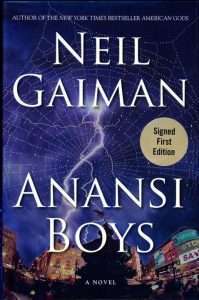 Anansi Boys is the American Gods spinoff I didn’t know I needed. Although it’s been many years since I read American Gods, Neil Gaiman immediately caught me in this web of a tale, a contemporary low fantasy steeped in West African folklore:
Anansi Boys is the American Gods spinoff I didn’t know I needed. Although it’s been many years since I read American Gods, Neil Gaiman immediately caught me in this web of a tale, a contemporary low fantasy steeped in West African folklore:
“Stories are webs, interconnected strand to strand, and you follow each story to the center, because the center is the end. Each person is a strand of story.”
Why are there so many trickster gods? Whether it’s the Norse god Loki, the Greek goddess Eris, or the Monkey King from Chinese mythology, it seems like every pantheon has a resident trickster. While I’ve personally grown weary of this trope, Neil Gaiman successfully converted this unbelieving arachnophobe into a fan of Anansi, the West African spider god of mischief.
We already met Anansi as “Mr. Nancy” in American Gods. Unfortunately for Mr. Nancy, he expires quite quickly in Anansi Boys, and in a rather embarrassing fashion, leaving behind two sons who never knew each other:
“Of course, everyone’s parents are embarrassing. It goes with the territory. The nature of parents is to embarrass merely by existing, just as it is the nature of children of a certain age to cringe with embarrassment, shame, and mortification should their parents so much as speak to them on the street.”
Charles Nancy, dubbed “Fat Charlie” by his father, didn’t inherit any of his dad’s divine powers. He works at a boring job in a shady investment firm in London and is preparing, rather unenthusiastically, to be married to his girlfriend Rosie.
But Charlie’s life is shaken up when his brother, Spider, enters his life. Spider shares his father’s mischievous nature and magical powers. He assumes Charlie’s identity—just for fun—inadvertently ruining his job and stealing his girlfriend in the process.
Charlie must seek supernatural help to fight back against Spider and reclaim his life. However, the help he receives may be more than he bargained for, as a spider’s natural enemy threatens even his own life.
Neil Gaiman proves once again to be a master storyteller with Anansi Boys, a delightfully dark tale that is also full of heart. My only regret is that the story took this long to find me.
Read Anansi Boys by Neil GaimanThe post REVIEW: Anansi Boys by Neil Gaiman appeared first on Grimdark Magazine.




